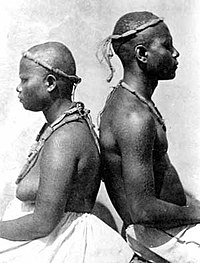Great Andamanese

Great Andamanese couple, in an 1876 photograph.
|
|
| Total population | |
|---|---|
| (52) | |
| Regions with significant populations | |
| Strait Island (India) | |
| Languages | |
| originally Great Andamanese languages, today mainly Hindi and other Indian languages | |
| Religion | |
| Hindu |
The Great Andamanese (Hindi: अण्डमानी Aṇḍamānī in Hindi) are an indigenous people of the Great Andaman archipelago in the Andaman Islands. Historically, the Great Andamanese lived throughout the archipelago, and were divided into ten major tribes. Their distinct but closely related languages comprised the Great Andamanese languages, one of the two identified Andamanese language families.
The Great Andamanese were clearly related to the other Andamanese peoples, but were well separated from them by culture and geography. The languages of those other four groups were only distantly related to those of the Great Andamanese and mutually unintelligible; they are classified in a separate family, the Ongan languages.
Once the most numerous of the five major groups in the Andaman Islands with an estimated population between 2,000 and 6,600, the Great Andamanese were heavily decimated by diseases, alcohol, colonial warfare and loss of hunting territory. Only 52 remained as of February 2010, and the tribal and linguistic distinctions have largely disappeared, so they may now be considered a single Great Andamanese ethnic group with mixed Burmese, Hindi and aboriginal descent.
The Great Andamanese are classified by anthropologists as one of the Negrito peoples, which also include the other four aboriginal groups of the Andaman islands (Onge, Jarawa, Jangil and Sentinelese) and five other isolated populations of Southeast Asia. The Andaman Negritos are thought to be the first inhabitants of the islands, having emigrated from the mainland tens of thousands of years ago.
...
Wikipedia
